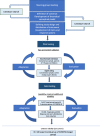The development of a questionnaire to assess leisure time screen-based media use and its proximal correlates in children (SCREENS-Q)
- PMID: 32397984
- PMCID: PMC7216486
- DOI: 10.1186/s12889-020-08810-6
The development of a questionnaire to assess leisure time screen-based media use and its proximal correlates in children (SCREENS-Q)
Abstract
Background: The screen-media landscape has changed drastically during the last decade with wide-scale ownership and use of new portable touchscreen-based devices plausibly causing changes in the volume of screen media use and the way children and young people entertain themselves and communicate with friends and family members. This rapid development is not sufficiently mirrored in available tools for measuring children's screen media use. The aim of this study was to develop and evaluate a parent-reported standardized questionnaire to assess 6-10-year old children's multiple screen media use and habits, their screen media environment, and its plausible proximal correlates based on a suggested socio-ecological model.
Methods: An iterative process was conducted developing the SCREENS questionnaire. Informed by the literature, media experts and end-users, a conceptual framework was made to guide the development of the questionnaire. Parents and media experts evaluated face and content validity. Pilot and field testing in the target group was conducted to assess test-retest reliability using Kappa statistics and intraclass correlation coefficients (ICC). Construct validity of relevant items was assessed using pairwise non-parametric correlations (Spearman's). The SCREENS questionnaire is based on a multidimensional and formative model.
Results: The SCREENS questionnaire covers six domains validated to be important factors of screen media use in children and comprises 19 questions and 92 items. Test-retest reliability (n = 37 parents) for continuous variables was moderate to substantial with ICC's ranging from 0.67 to 0.90. For relevant nominal and ordinal data, kappa values were all above 0.50 with more than 80% of the values above 0.61 indicating good test-retest reliability. Internal consistency between two different time use variables (from n = 243) showed good correlations with rho ranging from 0.59 to 0.66. Response-time was within 15 min for all participants.
Conclusions: SCREENS-Q is a comprehensive tool to assess children's screen media habits, the screen media environment and possible related correlates. It is a feasible questionnaire with multiple validated constructs and moderate to substantial test-retest reliability of all evaluated items. The SCREENS-Q is a promising tool to investigate children screen media use.
Keywords: Children; Correlates; Questionnaire; Screen-media use.
Conflict of interest statement
The authors declare that they have no competing interests.
Figures
Similar articles
-
Reliability and validity of psychosocial and environmental correlates measures of physical activity and screen-based behaviors among Chinese children in Hong Kong.Int J Behav Nutr Phys Act. 2011 Mar 8;8:16. doi: 10.1186/1479-5868-8-16. Int J Behav Nutr Phys Act. 2011. PMID: 21385418 Free PMC article.
-
HomeSTEAD's physical activity and screen media practices and beliefs survey: Instrument development and integrated conceptual model.PLoS One. 2019 Dec 31;14(12):e0226984. doi: 10.1371/journal.pone.0226984. eCollection 2019. PLoS One. 2019. PMID: 31891610 Free PMC article.
-
Reliability and validity of rapid assessment tools for measuring 24-hour movement behaviours in children aged 0-5 years: the Movement Behaviour Questionnaire Baby (MBQ-B) and child (MBQ-C).Int J Behav Nutr Phys Act. 2024 Apr 23;21(1):43. doi: 10.1186/s12966-024-01596-5. Int J Behav Nutr Phys Act. 2024. PMID: 38654342 Free PMC article.
-
A review of methods to assess parental feeding practices and preschool children's eating behavior: the need for further development of tools.J Acad Nutr Diet. 2012 Oct;112(10):1578-602, 1602.e1-8. doi: 10.1016/j.jand.2012.06.356. J Acad Nutr Diet. 2012. PMID: 23017568 Review.
-
Development of a 24-hour movement behaviors questionnaire (24HMBQ) for Chinese college students: validity and reliability testing.BMC Public Health. 2023 Apr 24;23(1):752. doi: 10.1186/s12889-023-15393-5. BMC Public Health. 2023. PMID: 37095458 Free PMC article. Review.
Cited by
-
Do young people perceive their smartphone addiction as problematic? A study in Danish university college students.Heliyon. 2023 Sep 25;9(10):e20368. doi: 10.1016/j.heliyon.2023.e20368. eCollection 2023 Oct. Heliyon. 2023. PMID: 37790974 Free PMC article.
-
Left to Their Own Devices? A Mixed Methods Study Exploring the Impacts of Smartphone Use on Children's Outdoor Experiences.Int J Environ Res Public Health. 2021 Mar 18;18(6):3115. doi: 10.3390/ijerph18063115. Int J Environ Res Public Health. 2021. PMID: 33803517 Free PMC article.
-
Effect of screen time on behavior of pre-schoolers in Islamabad.Pak J Med Sci. 2023 Mar-Apr;39(2):502-507. doi: 10.12669/pjms.39.2.6883. Pak J Med Sci. 2023. PMID: 36950435 Free PMC article.
-
Association of digital media use with sleep habits in school children: A cross-sectional study.Sleep Med X. 2024 Jun 12;8:100117. doi: 10.1016/j.sleepx.2024.100117. eCollection 2024 Dec 15. Sleep Med X. 2024. PMID: 38994446 Free PMC article.
-
Measuring effects of screen time on the development of children in the Philippines: a cross-sectional study.BMC Public Health. 2023 Jun 28;23(1):1261. doi: 10.1186/s12889-023-16188-4. BMC Public Health. 2023. PMID: 37380949 Free PMC article.
References
-
- Danmarks Statistik . Elektronik i hjemmet. 2019.
-
- Asplund KM, Kair LR, Arain YH, Cervantes M, Oreskovic NM, Zuckerman KE. Early childhood screen time and parental attitudes toward child television viewing in a low-income Latino population attending the special supplemental nutrition program for women, infants, and children. Child Obes. 2015;11(5):590–599. - PMC - PubMed
-
- Grontved A, Singhammer J, Froberg K, Moller NC, Pan A, Pfeiffer KA, et al. A prospective study of screen time in adolescence and depression symptoms in young adulthood. Prev Med. 2015;81:108–113. - PubMed
MeSH terms
Grants and funding
LinkOut - more resources
Full Text Sources
Medical



